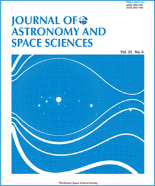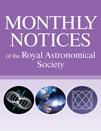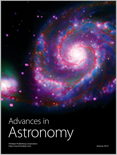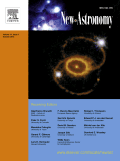
OBSERVATORY
Scope & Guideline
Unveiling the Mysteries: A Platform for Pioneering Research
Introduction
Aims and Scopes
- Astronomical Research and Discoveries:
The journal focuses on original research articles that present new findings in various areas of astronomy, including stellar dynamics, galaxy formation, and planetary systems. - Historical Perspectives in Astronomy:
A significant emphasis is placed on historical studies, examining the development of astronomical concepts and contributions from notable figures in the field. - Interdisciplinary Approaches:
'Observatory' encourages interdisciplinary work that connects astronomy with other fields such as physics, philosophy, and cultural studies, thereby enriching the understanding of astronomical phenomena. - Educational Resources and Guides:
The journal includes educational articles and guides aimed at both budding astronomers and seasoned professionals, covering topics from observational techniques to theoretical frameworks. - Conference Proceedings and Society Meetings:
Regular publications include proceedings from key astronomical meetings and conferences, facilitating knowledge sharing and collaboration within the astronomical community.
Trending and Emerging
- Multi-Messenger Astronomy:
There is a growing emphasis on multi-messenger astronomy, which combines observations from different cosmic messengers such as electromagnetic radiation, gravitational waves, and neutrinos, highlighting the interconnectedness of various astronomical phenomena. - Astrobiology and Exoplanet Studies:
Research related to astrobiology and the study of exoplanets has surged, reflecting a heightened interest in the potential for life beyond Earth and the conditions necessary for habitability. - Cultural Astronomy:
Emerging themes in cultural astronomy that explore the intersection of astronomy with art, history, and literature are becoming more prominent, showcasing the cultural significance of astronomical phenomena. - Data Science in Astronomy:
The integration of data science techniques in astronomical research is on the rise, pointing to a trend where large datasets are analyzed using advanced computational methods to derive new insights.
Declining or Waning
- Traditional Stellar Classification:
The frequency of papers dedicated to traditional methods of stellar classification has decreased, indicating a potential shift towards more dynamic methods such as multi-messenger astronomy and advanced observational techniques. - Historical Astronomical Instruments:
While historical studies remain relevant, there has been a noticeable decline in the specific focus on the intricacies of historical astronomical instruments, possibly due to a greater emphasis on contemporary instrumentation and methodologies. - Static Models of Cosmology:
The journal has seen fewer articles discussing static models of cosmology, suggesting a transition towards more complex and dynamic models that account for the expanding universe and dark energy.
Similar Journals

Journal of Astronomy and Space Sciences
Pioneering Insights into the Mysteries of Space.The Journal of Astronomy and Space Sciences, published by the Korean Space Science Society, is a premier open-access platform dedicated to advancing the fields of astronomy, astrophysics, and space sciences. Established in 1984, the journal has been instrumental in disseminating high-quality research findings, fostering collaboration among scientists globally, and providing insights into the dynamics of our universe. With an ISSN of 2093-5587 and an E-ISSN of 2093-1409, the journal has gained notable recognition, currently ranking in the Q3 quartile in Earth and Planetary Sciences and Physics and Astronomy as of 2023. Although the journal's H-Index is currently unspecified, its commitment to rigorous peer-review processes and open-access availability ensures that groundbreaking research is accessible to a wide audience. Based in Seoul, South Korea, the journal is poised to continue supporting innovative research through 2024 and beyond. Researchers, professionals, and students alike will find valuable resources and opportunities within its pages, further establishing this journal as a crucial resource in the exploration of the cosmos.

JOURNAL OF ASTROPHYSICS AND ASTRONOMY
Fostering Innovation in Celestial Research.JOURNAL OF ASTROPHYSICS AND ASTRONOMY, published by the Indian Academy of Sciences, stands as a pivotal resource for researchers and professionals in the fields of astrophysics and astronomy, with a rich history of publication dating back to 1980. This esteemed journal aims to disseminate high-quality research, fostering advancements in how we understand celestial phenomena, space environments, and planetary sciences. With a current Impact Factor that places it in the Q3 category for both Astronomy and Astrophysics and Space and Planetary Science, it maintains a crucial role in the global academic community, particularly within India. Although not an open access journal, its scholarly contributions are vital for both emerging and established researchers striving to push the boundaries of our knowledge in the cosmos. The journal is indexed in Scopus, ranking 56th in Astronomy and Astrophysics and 72nd in Space and Planetary Science, reflecting its ongoing significance and reach in the scientific dialogue.

MONTHLY NOTICES OF THE ROYAL ASTRONOMICAL SOCIETY
Unveiling the Mysteries of the Cosmos Since 1913.The MONTHLY NOTICES OF THE ROYAL ASTRONOMICAL SOCIETY (MNRAS), published by Oxford University Press, serves as a premier platform for the dissemination of significant research in the fields of Astronomy, Astrophysics, and Space and Planetary Science. Established in 1913 and with an impressive impact factor reflected in its 2023 Q1 rankings—13th in Earth and Planetary Sciences and 14th in Physics and Astronomy—this journal is renowned for its rigorous peer-reviewed articles, fostering advancements in our understanding of the universe. Researchers, professionals, and students alike benefit from its rich content, which spans a vast array of topics within its scope, from stellar dynamics to planetary formation. While the journal does not currently offer Open Access options, the scholarly contributions published herein are invaluable for pushing the boundaries of contemporary scientific inquiry and ensuring that the latest findings reach an engaged audience globally.

SOLAR PHYSICS
Transforming Solar Science: Insights for the Next GenerationSOLAR PHYSICS, published by SPRINGER, serves as a pivotal platform for the dissemination of groundbreaking research in the fields of Astronomy and Astrophysics, as well as Space and Planetary Science. With an impressive impact factor and ranked Q2 in both categories as of 2023, this esteemed journal has become integral for scholars seeking to advance their knowledge in solar phenomena and related disciplines. Originating from the Netherlands and converging from 1967 to 2024, SOLAR PHYSICS features a diverse array of articles, from observational studies to theoretical analyses, contributing significantly to our understanding of solar activity and its influence on the heliosphere and beyond. Researchers, professionals, and students alike will find this journal an indispensable resource for current trends and comprehensive insights in solar research.

SOLAR SYSTEM RESEARCH
Advancing Knowledge in Astronomy and BeyondSOLAR SYSTEM RESEARCH, published by Pleides Publishing Inc, offers a comprehensive platform for the exploration and dissemination of scientific knowledge in the fields of Astronomy, Astrophysics, and Space and Planetary Science. With its origins tracing back to 1969, this journal provides a vital resource for researchers and professionals seeking to deepen their understanding of the solar system's complexities, including planetary formation, extraterrestrial geology, and the dynamics of celestial bodies. Although categorized in the Q4 quartile for both relevant disciplines, SOLAR SYSTEM RESEARCH remains committed to publishing high-quality research that contributes to advancing contemporary scientific discourse. Dedicated to fostering collaboration and innovation, the journal is indexed in Scopus and adheres to rigorous academic standards, making it an essential resource for students and professionals alike pursuing the latest developments in solar system studies.

Advances in Astronomy
Exploring the Cosmos, One Discovery at a Time.Advances in Astronomy is a prestigious open-access journal published by HINDAWI LTD, dedicated to the field of astronomy and astrophysics. Established in 2008, the journal aims to disseminate significant research findings and advancements in the understanding of celestial phenomena, planetary sciences, and the intricate workings of the universe. With an impact factor that reflects its relevance in the scholarly community, Advances in Astronomy holds a commendable rank of Q3 in both Astronomy and Astrophysics as well as Space and Planetary Science categories, indicating its importance within these fields. The journal also showcases a commitment to open-access publishing, ensuring that research is readily available to both the scientific community and the public. Researchers, professionals, and students alike are encouraged to contribute to this dynamic forum to share knowledge and foster collaboration in exploring the wonders of the cosmos.

NEW ASTRONOMY
Advancing Understanding in Astronomy and AstrophysicsNEW ASTRONOMY, published by Elsevier, stands as a pivotal platform in the field of Astronomy and Astrophysics. With an ISSN of 1384-1076 and an E-ISSN of 1384-1092, this journal has solidified its reputation over its operational years, from 1996 to 2025. Located in the Netherlands, it ranks in the Q2 category for Astronomy and Astrophysics and Instrumentation, and Q3 for Space and Planetary Science, affirming its significant contribution to these disciplines. With a Scopus rank of #37/90 in Astronomy and Astrophysics and a respectable 59th percentile, this journal is essential for researchers and professionals seeking cutting-edge findings and methodologies. Although not open access, NEW ASTRONOMY remains dedicated to providing a rich repository of knowledge, featuring exceptional peer-reviewed articles that explore novel astronomical phenomena and advancements in instrumentation. Engaging with this journal will not only enhance your understanding of current trends in the cosmos but also contribute to the ongoing dialogue within these dynamic fields.

COSMIC RESEARCH
Illuminating the Mysteries of the CosmosCOSMIC RESEARCH is a prestigious academic journal dedicated to advancing the field of space science, particularly within the domains of aerospace engineering, astronomy, and planetary science. Published by MAIK NAUKA/INTERPERIODICA/SPRINGER, this journal has been a significant contributor to the scholarly discourse since its inception in 1968, with converged years showing robust publication activity until 2024. With a Q4 category ranking in various disciplines, including aerospace engineering, astronomy, and space science, the journal serves as a platform for disseminating innovative research and comprehensive reviews. Although not currently offering open access, COSMIC RESEARCH is renowned for its rigorous peer-review process, ensuring that only high-quality research is shared with the academic community. The journal's ISSN is 0010-9525 and its E-ISSN is 1608-3075. Researchers, professionals, and students alike can benefit from the insights and findings presented in this journal, making it an essential resource for anyone involved in the exploration of cosmic phenomena.

ACTA ASTRONOMICA
Unveiling the Secrets of Space: A Hub for Innovative ResearchACTA ASTRONOMICA, the esteemed journal published by the COPERNICUS FOUNDATION POLISH ASTRONOMY, is a pivotal platform for disseminating significant advancements in the fields of Astronomy, Astrophysics, and Space Science. With an established history spanning from 1996 to 2023, this journal maintains a strong position in academia, evidenced by its Q2 ranking in both Astronomy and Astrophysics as well as Space and Planetary Science categories. Targeted at researchers, professionals, and students, ACTA ASTRONOMICA offers a comprehensive collection of articles that foster a deeper understanding of celestial phenomena, planetary exploration, and theoretical advancements in the universe. While it is not an open-access journal, its structured format caters to a global audience eager to engage with cutting-edge research. Notably, its Scopus rankings highlight its relevance, placing it in the 56th percentile for Astronomy and Astrophysics and the 44th percentile for Space and Planetary Science, ensuring that contributors are part of an influential community that is shaping the future of astronomical study.

Advances in Astronomy and Space Physics
Illuminating the Universe Through Rigorous Inquiry.Advances in Astronomy and Space Physics is an esteemed journal dedicated to the exploration and dissemination of research in the expansive fields of astronomy and space science. Published by Taras Shevchenko National University of Kyiv, this journal provides a platform for researchers, professionals, and students to share groundbreaking studies and innovations. With an ISSN of 2227-1481, it covers a wide range of subjects including astrophysics, planetary sciences, and space exploration technologies, thereby fostering interdisciplinary collaboration. Although not an Open Access journal, it maintains a commitment to high-quality, peer-reviewed content that contributes significantly to the advancement of scientific knowledge. The journal's mission is to promote sustainable practices in space research while also exploring the implications of discoveries on Earth and beyond. By maintaining rigorous publication standards, Advances in Astronomy and Space Physics aims to serve as a critical resource for those involved in the ever-evolving study of our universe.